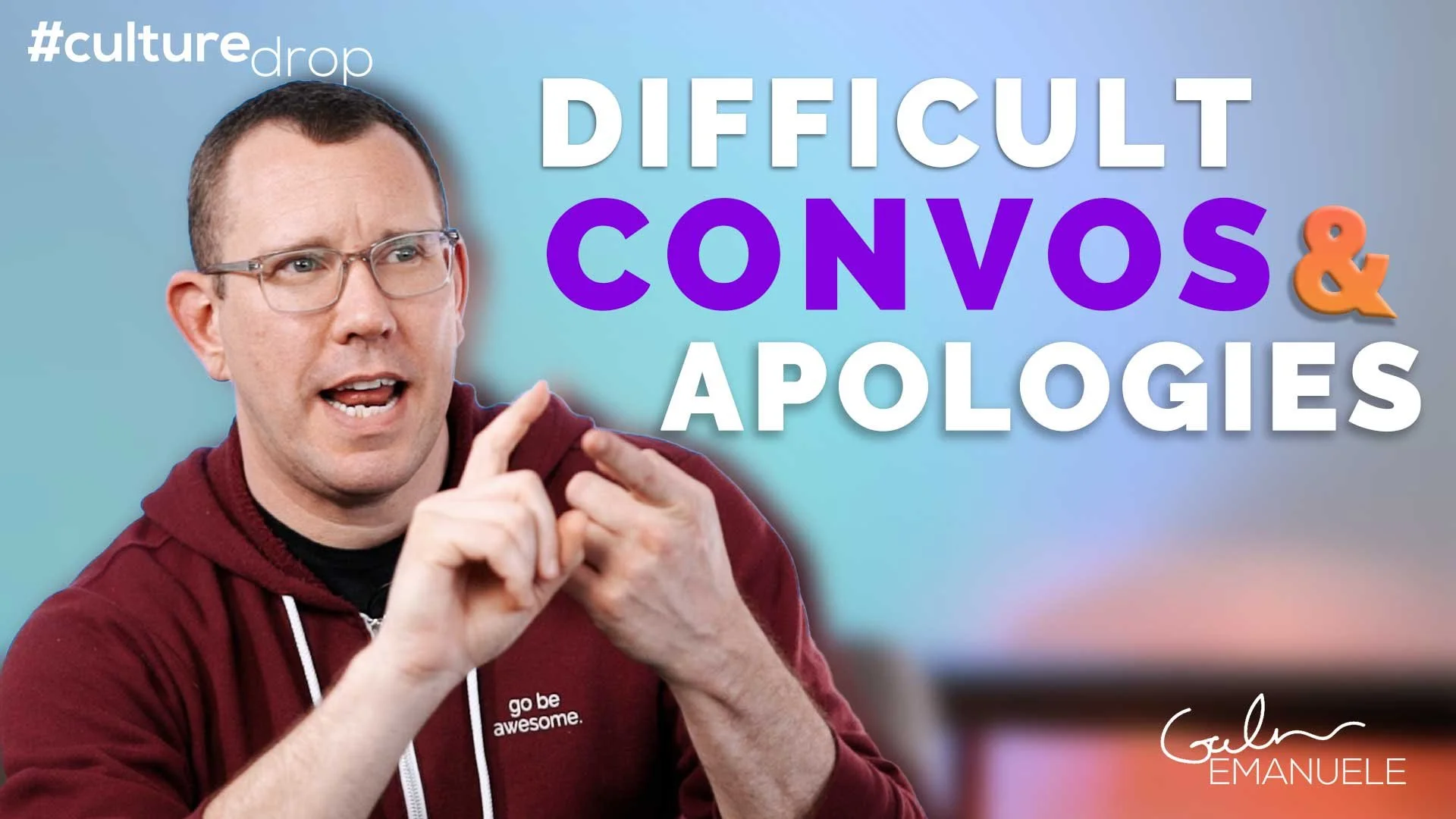Tips for Difficult Conversations & Apologies
Welcome to the #culturedrop. Every Tuesday, Galen Emanuele emails tools to advance leadership skills, team culture, and personal growth. No spam, just great content. Sign up now to get it in your inbox.
Navigating Difficult Conversations (and How to Apologize)
This topic came from a handful of questions and suggestions that came from the Culture Drop survey that everyone receives who is signed up for our email list (here’s where you can sign up). A number of people recently have asked for suggestions around how to have difficult conversations in a productive manner.
A very relevant and useful topic if you have any sort of work or personal relationships with other humans. Here is some guidance that I think is effective to approach difficult conversations & apologies.
Automatically yes, I know that this does not work in every possible context and circumstance. But if you care about the relationship, here are a few great tips to keep in mind to address, respond to, and disarm a potentially heated conversation.
As a perfect example, I’ll share a personal story that happened to me very recently.
A friend of mine and I were hanging out the other day at the store and I made a comment, teasing about something that is somewhat of an inside joke between us. My friend responded in a way that I think is a masterclass in initiating and addressing a difficult conversation.
They asked if they could share some feedback with me. I said yes, and they proceeded to let me know that what I had said, despite knowing that I had no intention of hurting their feelings, didn’t feel very great and had a negative impact on them. They told me that they knew my intention was to be silly and not to criticize or make them feel attacked, but my words did not land that way and they explained why.
They didn’t accuse me of being a bad person or doing something wrong, they didn’t label what I had said as mean, rude, or otherwise. They were calm and direct, simply making me aware of the impact my words had on them, letting me know how it felt to them and why.
There are a few important lessons to be taken from their approach that can be applied to many difficult or potentially heated conversations to (hopefully) produce a better outcome. These are not always easy to do in the moment. These take practice and intention to hone as skills in order to more effectively navigate challenging conversations.
1) Be gentle.
Some comments or situations can (rightfully) make us feel upset or triggered and immediately cause big emotions. Responding emotionally often serves to pour gas onto the situation and create defensiveness on both sides.
Remaining calm and approaching the conversation with some gentleness helps to steer and keep the conversation moving forward in a positive direction. This can be extremely hard to do, it’s a tough skill to master.
2) Ask for permission.
Another key to navigating difficult conversations that I really think is disarming and valuable is to ask the other person for permission to initiate the conversation or share some feedback with them. When you ask a person if you can share some feedback with them, they will almost always say yes.
When the conversation starts this way, it automatically puts the other person in a more receptive space because they have just said yes and agreed to hear what you have to share with them.
3) Assign positive intent.
It is also very disarming to assign positive intent on the part of the other person. Letting them know that you believe they had good intentions, but that what they did or said did not have a positive impact on you, and in fact did the opposite is useful.
By doing this, you avoid creating a narrative where they are the villain. When you assign positive intent to them, you extend the benefit of the doubt to them and reinforce that you don’t think that they meant to intentionally harm you or that they’re a bad person.
Nearly anyone hearing a story where they are the villain almost always puts them on the defense because no one believes (or wants to believe) that they are the villain in any story.
4) Be clear, direct, and succinct.
It’s always helpful if you can provide some context and understanding to the other person as to why the situation or their words impacted you in a negative way. Do it in a way that is clear, direct, and succinct. Focus on your experience and the impact on you, avoid accusing or labeling the other person of malicious intent.
*Disclaimer. some people are mean and do say things that are intentionally cruel and hurtful. In a situation like that, this is likely not be the most authentic or meaningful way to address the situation. This is really intended for a conversation between two people who care about having a healthy, positive working or personal relationship.
5) Apologize and take ownership.
To wrap up, let’s talk about being on the other end of this conversation, where you are the one who impacted someone negatively. It’s important to resist the tendency to deflect blame or be defensive or dismissive when someone tells us how we have hurt them.
If you care about the relationship, then it’s extremely important to the health of that relationship that you take full ownership of the impact that you have on that other person, regardless of your intent.
Instead of saying “That’s not what I meant”, or “I was just teasing,” validate their concerns and let them know you care about them by taking ownership and apologizing for the impact your words or actions had.
This can be as simple as “I am sorry that I said ——. I did not intend to have that impact on you, I apologize. Thank you for sharing that with me, I heard you and I’ll do better.”
Final Thoughts
Navigating difficult conversations does not have to be hard. Extend grace to the other person. and focus on the impact over the intent. When having a difficult conversation, prioritize the relationship above all. Own your impact, not just your words or intent.
Want more?
This article was created by Galen Emanuele for the #culturedrop. Free leadership and team culture content in less than 5 minutes a week. Check out the rest of this month's content and subscribe to the Culture Drop at https://bit.ly/culturedrop








